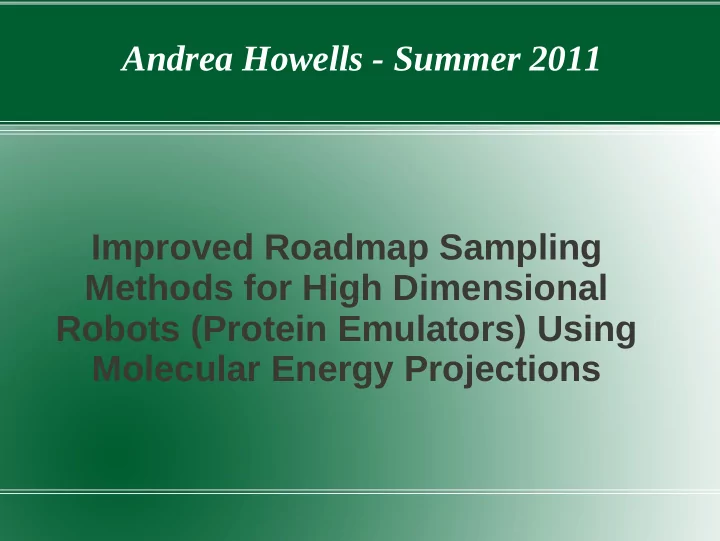

Andrea Howells - Summer 2011 Improved Roadmap Sampling Methods for High Dimensional Robots (Protein Emulators) Using Molecular Energy Projections
The Team ● Lydia Tapia – Assistant Professor ● Latha Doddikadi - graduate student ● John Baxter - graduate student ● Andrea Howells - undergraduate student ● Rachel Webster - undergraduate student ● Anthony Lee Hickerson – undergraduate student ● My role in this project is to determine improvements needed to current probabilistic roadmap method software developed for robotic motion planning to map protein folding pathways.
PRM ● PRM – Probabilistic Roadmap Methods ● PRMs were originally developed for robotic motion planning ● Builds a graph corresponding to an approximate map of the molecule's energy landscape ● Encodes many folding pathways ● Properties of interest, secondary structure formation order, subtle folding differences and relative folding rates can be captured
The Project AIDS virus ● Three year project ● Investigation of the role of protein motion in determining binding affinities between peptide, MHC (Major histocompatability complex), and TCR (T cell receptors) molecules ● Information will be used to understand the specificity of immune responses which can then be used in vaccine research Caption: This model of the his model of HIV is the most detailed 3-D model of the virus ever made. It summarizes the results from scientific publications in the fields of virology, X-ray analysis and NMR spectroscopy. The depicted spatial configurations of proteins found in HIV particles are in strict accordance with their known 3-D structures. This image relates to the 2010 International Science and Engineering Visualization Challenge appearing in the Feb. 18, 2011, issue of Science, published by AAAS. Credit: Image courtesy of Ivan Konstantinov, Yury Stefanov, Aleksander Kovalevsky, Yegor Voronin - Visual Science Company Usage Restrictions: None
Vizmo – node and edge generation ● Familiarized with a road map program - ran program changing parameters to learn which parameters affect node generation ● Familiarized with a node generator, BasicPRMStategy for pathfinding ● Viewed results of parameter changes using Vizmo, to view the nodes and edges generated ● Parameter variations evaluated to determine best performance versus cost, using MCH, TCR and 1QLP(1 Alpha Antitrypsin) 1QLP was chosen as a representative protein as it is much than MCH and TCR
1QLP Layer Times, Rejects 1600 1600 1600 1600 1600 1600 1600 1600 1400 1400 1400 1400 1400 1400 1400 1400 1200 1200 1200 1200 1200 1200 1200 1200 1000 1000 1000 1000 1000 1000 1000 1000 Layer size Layer size Layer size Layer size 800 800 800 800 800 800 800 800 600 600 600 600 600 600 600 600 400 400 400 400 400 400 400 400 200 200 200 200 200 200 200 200 0 0 0 0 0 0 0 0 0 1 2 3 4 5 6 7 8 9 0 1 2 3 4 5 6 7 8 9 0 1 2 3 4 5 6 7 8 9 0 1 2 3 4 5 6 7 8 9 Layer Layer Layer Layer 1QLP Run Times Q Chain Angles 0.5 to 10 Q Chain Angles 0.5 to 10 30000 30000 84:00:00 25000 25000 72:00:00 Pflex: 0.06 Prigid: 0.05 Pflex: 0.06 Prigid: 0.05 Pflex: 0.06 20000 20000 60:00:00 51:48:36 51:48:36 Prigid: 0.05 Pflex: 0.06 Prigid: 0.005 Pflex: 0.06 Prigid: 0.005 Pflex: 0.06 Rejects Rejects 15000 15000 38:43:50 38:43:50 Prigid: 0.005 48:00:00 Pflex: 0.06 Prigid: 0.0005 Pflex: 0.06 Prigid: 0.0005 Pflex: 0.06 43:57:12 43:57:12 Prigid: 0.0005 10000 10000 36:00:00 Pflex: 0.01 Prigid: 0.0005 Pflex: 0.01 Prigid: 0.0005 Pflex: 0.01 78:23:55 78:23:55 Prigid: 0.0005 5000 5000 24:00:00 0 0 12:00:00 0.5 0.5 1 1 1.5 1.5 2 2 2.5 2.5 3 3 3.5 3.5 4 4 4.5 4.5 5 5 5.5 5.5 6 6 6.5 6.5 7 7 7.5 7.5 8 8 8.5 8.5 9 9 9.5 10 9.5 10 Angle Deviations Standard Angles 00:00:00
The Work ● Code modifications to Multiple Articulated Linkages code Free or un-bound multiple robot bodies with articulated links will be used to simulate the protein molecule's energy landscape. ● Adding ability to evaluate Arbitrary links ● Challenges – no formal training in C or C++ ● Debugging - ● Addition of print statements ● Use of internet ● To determine meaning of error messages ● To determine possible corrections ● Website - http://www.cs.unm.edu/~ahowe003
My Sponsor My participation in this project is supported by a DREU (distributed research experiences for undergraduates) internship funded by CRA-W.
Recommend
More recommend